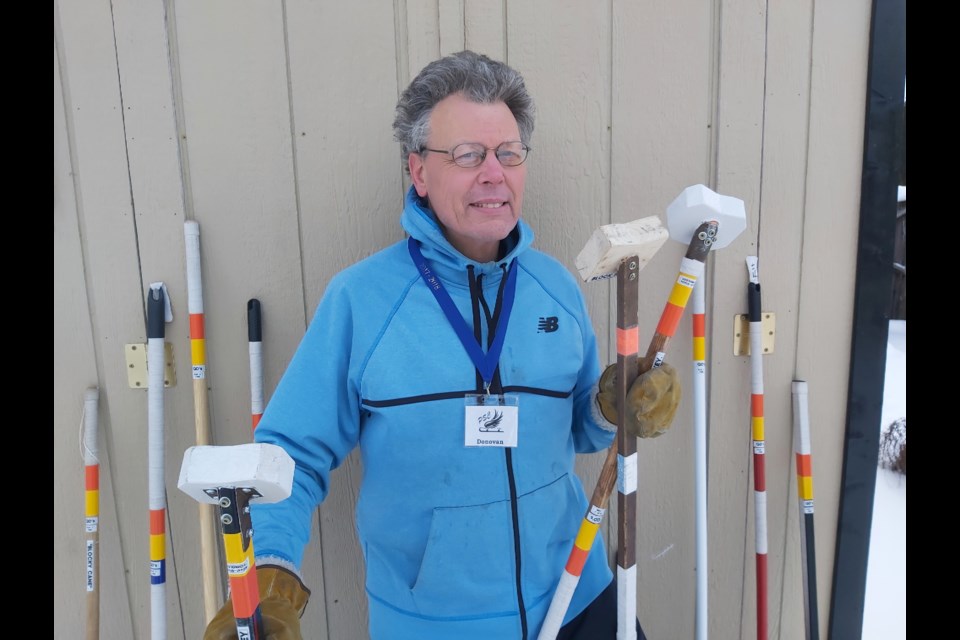Donavon Quackenbush has developed a device that could prove to be a godsend for parents trying to coax their little ones onto the ice.
The Midland man says his Block Hockey stick, which also features a similar prototype going by the ‘Blocky Cane’ moniker, could help those with special needs or who have vision impairments more easily take to skating while also aiding the environment since it finds a new use for broken hockey sticks.
“A Block Hockey stick allows four-direction motion, and combines the concept of ringette and shuffleboard, but uses a hockey puck and is safe as it keeps the puck safely on the ice,” Quackenbush explains during an interview outside his workshop.
Quackenbush, who volunteers as a skating coach at the Penetang Skating Club, says the device's key is its ability to keep those learning to skate engaged as it can help them keep their balance and focused on moving ahead a puck, which fits perfectly in the stick's head.
It was back in the fall when Quackenbush came up with his new stick proposal as a way to teach kids to skate better, have more fun and to reward them to keep them interested in the ice time left after their lessons.
He set about building his first prototypes on November 25 and 26 and tested it the following day and again at the start of December at the Penetang Skating Club and notes both trials were met with “incredible success.”
“I never imagined that a Block Hockey stick would have had such value to the kids until I saw it with my own eyes,” says Quackenbush, a widower, cancer survivor and father of two sons.
Quackenbush, 61, grew up on hockey skates, practising his moves on a swamp near Parry Sound. He eventually decided to try figure skating and for the past number of years has been helping the younger Penetang Skating Club members learn how to skate.
“So back around 1998, I bought a good pair of men's (figure skates), and I pursued learning to skate on figure skates and have been assisting the Precan/Canskate 1, for years, and also with Canskate 2, and Can Power,” Quackenbush explains.
“I also have developed the skill to go back and forth between figure and hockey skates, as, often, skating coaches teach both figure and power and that skill greatly impressed me.”
Quackenbush, who volunteers at the Penetanguishene club under head coach Sundae Brown, also skated under coach Jan Hume, of Stayner’s SK8 Georgian Bay.
“She mentored me and made a great deal of who I am today as a volunteer amateur skating coach,” he says.
Prior to developing the stick, Quackenbush would often bring out toy plungers when teaching very young skaters.
“The kids would have fun learning to balance, walk and skate while stacking rings on the plungers, and would use the plungers to push balls or hockey pucks around the ice,” he says.
“That taught skating skills while keeping them interested and having fun. Parents who see and feel their kids are learning, are happy parents and are happy to pay for the lessons.
“Young kids are sponges to new things, brains eager to learn. They quickly learn to balance on skates, want to take steps to get to outreached hands, carry toys on skates to put in buckets, stack rings carried to posts on skates, grasp, and track things they see.”
A retired electronics engineering technologist, Quackenbush engineered the stick to the following specifications: 100mm wide block, with a 10mm depth "V", on the forward face, about 40mm thick and attached to various length hockey, ringette, and/or sweeper broom handles, at a 45-degree angle with different lengths for different skaters.
“A version on a high-value, carbon-fibre hockey stick handle was very lightweight with an incredibly great touch,” he said, noting the forward ‘V’ captures a hockey puck and allows forward capture similar to shuffleboard while the 10 mm sag was designed to geometrically draw a puck sitting against the boards.
“Can Power skaters using this for training will develop greater puck control as only 90 mm of side length is available. Also since the 100mm back side is flat, back skating skills while pulling the puck backwards, would be greatly improved.
“And, forward stride stance and development would also be enhanced as the puck is captured in forward motion.”
Upon further testing, Quackenbush determined it could be used to assist special needs, and the blind to skate, and could be used by seniors, via what he calls the “Blocky Cane.”
“A small redesign of the Blocky Cane was carried out, which incorporates an adjustable length handle,” he says. “Block Hockey sticks would also be environmentally friendly as they could be manufactured from recycled materials.”
Brown, who has coached skating for about 40 years, including 15 as head coach in Penetanguishene, says Quackenbush’s Block Hockey invention could really help those just starting out.
“It’s great, especially for the younger skaters, the ones who are really young,” Brown says, noting she also sees the stick’s potential to help those with vision deficiencies.
“The kids get control pushing the puck. It’s a really safe thing because it keeps the puck on the ice."
Quackenbush is in the process of marketing the stick, having sent out feelers to companies and officials like Simcoe North MP Adam Chambers.
“This simple device was tested and would greatly improve power skating and hockey skills as it promotes incredible hand accuracy and four-axis puck control, but safely keeps the puck as a tool and on the ice,” he says, noting seniors would also like it since it helps with balance and could be used during public and senior skating sessions where hockey sticks are normally prohibited.
“I also believe if Skate Canada could see what is going on in Penetang, they would be amazed with the Block Hockey concept.”

.png;w=80;h=120;mode=crop)
